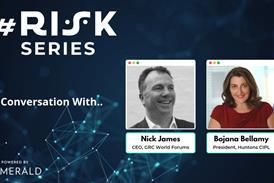FinCrime Focus: Anti-Money Laundering delivered expert insight and guidance for financial leaders and senior practitioners working within financial crime.

The one-day livestreaming experience saw over 20 subject-matter experts giving their views through presentations and panel debates across a packed content agenda.
Key topics for discussion included the outlook for fincrime in 2022; how to build an effective AML/KYC compliance programme, and how automation and other cutting-edge tech tools are underpinning the fight against the financial criminals.
The morning sessions began with an appraisal of the complex web of financial crime that organisations and authorities are having to deal with, post-pandemic.
Commenting on current illicit trends, Richard Parlour, CEO at Financial Markets Law International, cited cybercrime as “now in the world’s top five crimes.”
Passing judgement on the biggest challenges facing financial institutions, director at Financial Crimes Compliance, Hemanshu Parekh, said:
“The biggest challenge for financial institutions is data, precisely the availability, accessibility and usability of data. These three factors are crucial. [The] good news is that banks started using data and tech departments are using it the right way although they are already late to the race.
Nicky Gomez of XReg Consulting, said:
“Do a proper business risk assessment, invest time in understanding your business, products and threats and use that to prioritise the way you will mitigate those risks.
“We need to try and find a way around the Brexit issues so that the UK can get access to as much data as it used to,” Richard Parlour added.
FinCrime and AML went under the spotlight in the second session of the day, with a specialist panel exploring how Brexit, the Covid crisis, and Russia’s invasion of Ukraine are being exploited by global crime networks.
Shawki Ahwash, Head of AML/CFT & Sanctions Division, MLRO at North Africa Commercial Bank sal-Beirut, said:
“[Regarding] the AMLA reforms, banks are good at writing policies but I am afraid these policies not being integrated in the core systems and compliance solutions they implement.”
“The sanction screening process should be well calibrated in terms of updating of the list, updating the number of false positive and true positives, which may be tedious. On KYC level, we need to scratch the surface when it comes to customer screening to recognise the sanctions.”
In the midday session, Threat Analytics EMEA at BioCatch, Kate Fox, looked at how state-of-the-art smart phone analyses are helping to root out money mules.
“Everyone swipes differently on their mobiles. Based on the patterns we record with BioCatch technology, we can identify changes and potential additional users of the same account. Not only we can look at swiping patterns, but also typing ones. When identifying different users, we know we might be dealing with mules,” Kate said.
“It’s those key behaviour features that help us spot mule activity, especially when dealing with accounts that might have been dormant for a long time,” she added.
In the afternoon, experts at FinCrime Focus: Anti-Money Laundering spoke about AML transaction monitoring and the role it plays in a strong governance framework.
Marcos Tinedo, Head of Compliance Assurance - Monitoring & Testing / Transformation, at Billpocket, said:
“It’s important to differentiate fraud transaction monitoring from AML transaction monitoring, as the focus is shifted to different aspects.”
Dr. Mayya Konovalova, Lecturer/Researcher in Accountancy, Taxation, and Anti-Money Laundering at the University of Birmingham, said:
“It’s important to understand what the regulators aim at. It’s also important to consider the human factor and the company’s culture.”
“Financial firms are in the business of making money, not in the business of policing. But I think it’s very important to realise that the company culture needs to be discussed, and people need to be motivated to take the right precautions on, and be rewarded for that as well,” Dr. Konovalova added.
Marcos Tinedo continued:
“It’s important to have data quality management during the whole process, as well as calibrated scenarios, to avoid noise or productive alerts, false positives and calibration problems.
“It’s important to also update your thresholds according to your operations, because if not your suspicious activity might result in an increase without a reason to,” Marcos Tinedo concluded.
The following session took a closer look at the core elements of an effective global AML/KYC compliance programme, at a time when AML professionals are under pressure to demonstrate the success and efficiency of the programmes they build.
Sujata Dasgupta, Global Head of Financial Crime Compliance Advisory at Tata Consultancy Services, cited “governance, execution and monitoring” as the three frameworks with which institutions should align.
Devraj Basu, Senior Lecturer in Finance, Accounting and Finance Department at Strathclyde Business School, said:
“If you can do an enterprise architecture and share it globally, use multiple data streams on Policies, Procedures and Control.”
Compliance Manager, MLRO at Gulf Exchange, Talal Shoukat, said:
“You need to strengthen your global presence in countries you are working with, and minimum global level standards should be followed. Policies, Procedures and Control should be flexible, effective and proportionate to match the global level.”
“Employee training is one of the important factor, e-learning should be an approach for global training, internal and external audit is also key for a global enterprise,” Talal Shoukat added.
Thought leaders at FinCrime Focus: Anti-Money Laundering then took a transatlantic take on AML regulations, drawing comparisons between reform proposals in the EU and in the US.
Commenting on the documents needed to verify beneficial owners in the US, Gustavo Enrique Nuñez Leyba of Multibanco International, said:
“If you have control or ownership of 25 percent or more of a company, you need to verify and get a license. In some institutions, it is a 10 percent in the KYC perspective, which is more rigid.”
The final session of the day at FinCrime Focus: Anti-Money Laundering brought audiences up to speed with the latest tech wizardry that’s helping to undermine financial crime.
Such is the scale of financial institutions’ AML efforts, that automation has grown to become a crucial tool to help spot and report suspicious transactions. Machine learning techniques can not only ensure more effective AML monitoring, but also offer a more efficient way to fight the money criminals.
Michael Harris, Financial Crime Compliance Consultant at FCC Consulting, said:
“Most AI solutions that I am aware of are concerned with making sure there is no data breach. I need enough data to make a decision about if someone is committing financial crime or not.”
Dr. Seun Ajao, Senior Lecturer and Course Leader in Data Analytics at College of Business, Technology and Engineering, Sheffield Hallam University, said:
“Data is very important; it is arguable if we should have good data or a good AI model. Although if you have bad data you can’t have a good AI model.
“These AI models need examples of what a suspicious transaction looks like or you will put yourself in a situation where you get lots of false positives. Having the right data is important to make the right decisions,” Dr Seun Ajao added.
Richard Self, Leadership and Keynote Speaker and Research Fellow - Big Data Laboratory at the University of Derby, said:
“You have to ask yourself: are you using AI to make your team effective or are you implementing it to get rid of them, because [the latter] is not going to work.”
A huge thank you goes out to our experts, thought leaders and subject matter experts at FinCrime Global, and of course to all those who tuned in to the exclusive livestreaming experience.
FinCrime Global was hosted by GRC World Forum.





















No comments yet